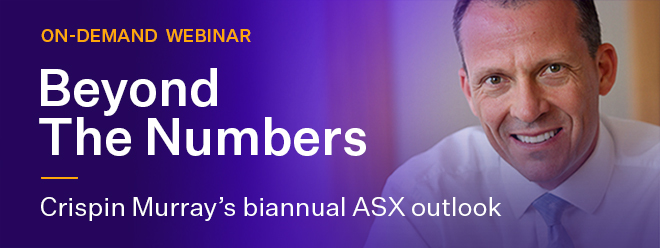Here are the main factors driving the ASX this week, according to Pendal investment analyst JACK GABB. Reported by portfolio specialist Chris Adams
- Find out about Pendal Focus Australian Share fund
- NEW: Watch Crispin Murray’s bi-annual Beyond The Numbers ASX outlook
THE first central bank domino fell last week.
The Swiss National Bank pushed through a surprise 25bp cut to 1.5%, pre-empting expected moves by the US Fed and European Central Bank as soon as June.
The Fed kept rates unchanged but reiterated that it expects three cuts this year.
The ECB continues to flag June as the month by which it should know whether to cut. And even Bank of England hawks have dropped their push for more hikes.
It is small wonder then that the Reserve Bank of Australia walked back commentary warning of further hikes.
In short, most central banks appear increasingly poised for a scramble to cut rates, despite plenty of macro-level data suggesting there’s no need to do anything quickly.
Against that backdrop the S&P 500 rose 2.31% (its best week since January) and hit another record high – its 20th year-to-date.
The S&P/ASX 300 also managed reasonable gains, up 1.29%.
Though neither matched Japan. The Nikkei jumped 5.6% on further signs the economy was strengthening – forcing the Bank of Japan to raise rates for the first time in 17 years.
Bonds rallied on higher rate-cut expectations, with yields on longer-dated Treasuries ending the week on lows.
It’s been a volatile month and a tough quarter for commodities, though most moved higher last week.
In particular lithium spodumene rose 18.2%, recovering from an oversold position.
Oil ended the week flat, giving up mid-week gains. Brent crude remains up 11% YTD, but lower gas prices and freight rates are acting as an inflationary offset.
Commodity Trading Adviser positioning in commodities was unchanged from the previous week with strategies continuing to hold “max long” positions in oil and gold, silver and copper.
Rate expectations
The US Fed remains odds-on to cut in June. Expectations were up 19% last week despite better-than-expected economic data released after the meeting.
We also note the Core Personal Consumption Expenditures (CPE) index – the Fed’s preferred gauge of inflation – is accelerating.
In Australia, stronger unemployment data offset the RBA’s shift to a more neutral stance, with a full cut now not priced in until November (versus September previously).
However, if the Fed and ECB cut in June, pressure will mount for the RBA to follow sooner.
US outlook
The Fed held rates unchanged for the fifth meeting in a row, as expected.
More importantly, it stuck to its view of three cuts by year-end. This was the main driver of a positive market reaction, though we recall the market started the year pricing in seven cuts.
As has previously been discussed, US inflation continues to move in the right direction despite the odd bump.
The Fed “judges that the risks to achieving its employment and inflation goals are moving into better balance”, according to Fed chair Jay Powell.
However it was a lot closer than the market reaction suggested.
Changes in the “dot plots” of each member’s expected rate levels very nearly skewed the median towards two cuts – which would likely have driven a different market reaction.
The market was also happy to shrug off a reduction in expected cuts next year from four to three, as well as a lifting in long-term rate expectations from 2.5% to 2.6%.
Other key changes to 2024 forecasts included raising expected inflation from 2.4% to 2.6%, expected GDP from 1.4% to 2.1% and cutting expected unemployment from 4.1% to 4%.
Powell also said it would be appropriate to begin tapering so-called quantitative tightening “fairly soon”.
Better GDP and employment forecasts weren’t the only indicators that the US is economy is doing well.
In data released after the Fed meeting, existing home sales rose 9.5% month-on-month to 4.38 million – the highest point over the past year and ahead of an expected 3.95 million.
The Conference Board Leading Index (a composite index that averages ten key economic variables) also rose 0.1% for the month, versus an expected 0.1% fall. It was the index’s first rise since February 2022.
As we highlighted back in November, this index has bottomed at a median of 61 days before the end of every recession since the 1969-70 downturn – and stocks have gained a median 23.4% in the year after these troughs.
The most recent trough was April 2023. Since then the S&P 500 is up 26%.
In short, the data is coming in stronger. However, as one commentator put it: “This is a Fed that wants to cut rates.”
The next Fed meeting is May, though the market is only pricing in a 16.5% chance of a cut then.
Instead, committee members are likely to wait for more CPI prints. Three more are due before the June decision, with the last one the day before their next meeting.

Pendal Focus Australian Share Fund
Now rated at the highest level by Lonsec, Morningstar and Zenith
It seems inconceivable that the Fed could cut in November given the US presidential election.
So that leaves just four meetings (June, July, September and December) to put through three cuts.
Australia
There were no surprises from the Reserve Bank’s mid-week meeting (rates were held at 4.35%), though we noted a change in language “in response to some data that makes us more confident about the path we are on”.
The RBA effectively walked back commentary warning of further hikes, by “not ruling anything in or out” rather than the previous “a further increase in interest rates cannot be ruled out”.
Semantics maybe, but there’s no doubt the previous stance was increasingly at odds with other central banks eyeing rate cuts sooner.
At this point the Fed is rated 85% chance of a cut by the end of June, the ECB above 90% and the RBA at only 40%.
There are three factors affecting the outlook for Australian interest rates:
1) Labour market challenges remain
One issue the RBA has to contend with is continued strength in the labour market.
Data after the RBA meeting revealed unemployment declined to 3.7% in February, down from 4.1% prior (4% expected). Some 116,500 jobs were added in the month versus 40,000 expected (500 prior).
While the data can be volatile, it nevertheless challenges a dovish view and sent rate cut expectations lower.
We note that is a parallel with the Fed, where Powell has previously noted that “in and of itself, strong job growth is not a reason for us to be concerned about inflation”.
This is only an issue if workers are spending and driving up inflationary pressures. Still, it is something to watch.
2) Then there’s the tax cuts
Some $20 billion in annual income tax cuts will begin kicking in from July 1.
This is clearly inflationary – some estimates say it is worth two-to-three rate cuts – and may well encourage the RBA to pause while gauging the inflationary impact.
3) Borrowers are coping
Commentary from the RBA Financials Stability Review added more weight to a hold-for-longer view.
Despite mortgage repayments rising 30-60% since May 2022, borrowers are seen as being able to cope if rates stay higher for longer.
While arrears would rise, they are expected to remain low at less than 1% in terms of home loans 90 or more days in arrears.
Japan
As expected, the Bank of Japan became the last central bank to exit the era of negative interest rates, raising the benchmark to an eye-watering 0.0-0.1% from -0.1% – the first increase in 17 years.
The move marks a step back towards mainstream central bank policy after decades of experimentation.
While negative rates no doubt helped stem the tide of deflation, ultimately it was quantitative easing, Covid and Russia’s invasion of Ukraine that drove inflation back above 2%.
As a former BOJ director in charge of monetary policy said: “the negative rate did nothing, nothing at all” to stoke inflation.
Interestingly, the start of Japan’s last three hiking cycles (going back to 1986) has preceded a global recession.
Though we note that is clearly at odds with most of the current macro data.
Markets
It was a good week for nearly all sectors in the US last week.
Tech stocks continued to do a lot of the heavy lifting – apart from Apple, which fell on an anti-trust investigation.
Artificial intelligence was again front and centre with Nvidia up for the 11th straight week after holding its GTC event (the ‘Woodstock of AI’) which packed in some 11,000 people.
Industrials also did well with bellwether FedEx reporting a third-quarter beat.
Real estate was weaker, with Equinix down on a short report.
Elsewhere Nike and Lululemon reported weaker results – the latter warning it had seen a shift in the shopping behaviour of its high-end US consumers.
Overall though it was a good week, pushing the price/earning multiple back to January 2022 levels. Materials led in Australia, offsetting weakness in utilities and consumer staples.
About Jack Gabb and Pendal Focus Australian Share Fund
Jack is an investment analyst with Pendal’s Australian equities team. He has more than 14 years of industry experience across European, Canadian and Australian markets.
Prior to joining Pendal, Jack worked at Bank of America Merrill Lynch where he co-led the firm’s research coverage of Australian mining companies.
Pendal’s Focus Australian Share Fund has an 18-year track record across varying market conditions. It features our highest conviction ideas and drives alpha from stock insight over style or thematic exposures.
The fund is led by Pendal’s head of equities, Crispin Murray. Crispin has more than 27 years of investment experience and leads one of the largest equities teams in Australia.
Pendal is a global investment management business focused on delivering superior investment returns for our clients through active management.
In 2023, Pendal became part of Perpetual Limited (ASX:PPT), bringing together two of Australia’s most respected active asset management brands.
Find out more about Pendal Focus Australian Share Fund
Contact a Pendal key account manager
As investors prepare for lower rates, our head of income strategies AMY XIE PATRICK sat down with portfolio specialist DALE PEREIRA to answer some common client questions
DALE PEREIRA (Pendal’s head of client solutions): As economic growth slows and inflation comes under control, markets are expecting interest rates to fall in the US and Australia this year.
How are you managing fixed income portfolios in this environment?
AMY XIE PATRICK (Pendal’s head of income strategies): “We manage our portfolios to a simple philosophy when it comes to the interest rate cycle.
“When the RBA is hiking interest rates, we like to take our credit exposures in floating-rate form.
“This means the income returns of the portfolio will be able to keep up with the rising interest rate environment.
“But when the RBA is cutting interest rates, we like to switch our exposures to fixed rate. This locks in a higher level of income, even as interest rates fall to much lower levels.
“It’s the same as a homeowner taking out a mortgage, only in reverse.
“When you think the RBA is going to cut interest rates, you want your mortgage rate to be variable so those rates fall as the RBA slashes rates.
“When you think the RBA is going to raise rates, you fix the rate on your mortgage at low levels.
“We do the same thing for Pendal Monthly Income Fund portfolio – but we want as high a yield as possible.”
Dale: Are you fixing the rate of your credit portfolio now?
Amy: “We’re not rushing to do it just yet.
“Bond yields do look really attractive compared to the last decade. But when you take a longer-term perspective, these are just more normal levels of interest rates.

“The RBA is also not entirely convinced that it’s won the inflation battle, especially with strong immigration flows still pushing up demand in our economy.
“So we’ve been dipping our toes in, but we’re not yet ready to fix the whole portfolio.
“By doing it in slices, it maintains flexibility in our portfolio as well as protection in case bonds have another sharp sell-off like they did last October.
Dale: What signals indicate it’s time to turn your income portfolio towards fixed-rate assets rather than floating-rate bonds?
Amy: “Wages matter to the RBA almost more than any other central bank.
“I’d want to see wage inflation in Australia roll over and head convincingly down to that 3.5% type of level where the RBA feels is consistent with their 2% to 3% inflation target.
“Our proprietary wage indicators at Pendal have stopped rising, but they appear a bit sticky at just over 4%.
“That doesn’t mean there won’t be opportunities along the way in rates.
“We will seize these opportunities with our active interest rate process just like we did during the regional banking crisis in the US last year and during the fourth quarter of 2023.”
Dale: Most of us think of fixed income as a defensive asset class. When equities are strong and the market isn’t worried – and isn’t looking for protection – why bother with bonds?
Amy: “My career in markets has taught me that bonds will do their own thing.

Find out about
Pendal’s Income and Fixed Interest funds
“There is no hard rule that says bonds have to go up when equities go down.
“The main things that drive bond performance are growth and inflation. The macro fundamentals are usually what matters to bond market direction.
“For example, in 2022 bonds didn’t work to protect against falling equities because inflation was a far bigger problem than slowing growth.
“Today growth is still not a problem, but inflation is coming down all over the world. The shocks from the pandemic are finally working their way out of the system.
“If the downward inflation trend continues, bonds can still do well regardless of whether the economy slows from here.
“Look at 2023, Australia grew more than 2% and yet Aussie government bonds returned more than 5%.
“The US economy grew at over 3% and global bonds returned close to 6%.
“Those data points tells us you don’t need to be bearish on the economy in order to be bullish about bonds in your portfolio. “
“While cutting cycles are great for bonds, actually the best time for bond returns is simply when the hiking cycle stops.
“Bonds tend to outperform equities in this part of the cycle.
“That means you’re coming into the best period for bond returns right now. And wouldn’t it be a shame to say no to bonds and miss out on all this opportunity?”
Dale: Why would you invest in a bond portfolio rather than a term deposit?
Amy: “For some investors, term-deposit returns on cash are enough – they’re more than happy to take those returns after years of really slim pickings in this area.
“But for most investors who chose term deposits over fixed income last year, their biggest frustration was missing out on the upside.
“Both bonds and equities outperformed term deposits in 2023.
“This year, locking in 5% term deposits might sound nice at first.
But you would also be locking up your capital for a year.
“It makes it harder to move your money around when things change, which means you can’t deploy it quickly or easily to buy the dip if we get a decent correction in markets.”
About Amy Xie Patrick and Pendal’s Income and Fixed Interest team
Amy is Pendal’s Head of Income Strategies. She has extensive expertise and experience in emerging markets, global high yield and investment grade credit and holds an honours degree in economics from Cambridge University.
Pendal’s Income and Fixed Interest boutique is one of the most experienced and well-regarded fixed income teams in Australia. The team oversees some $20 billion invested across income, composite, pure alpha, global and Australian government strategies.
Find out more about Pendal’s fixed interest strategies here
About Pendal Group
Pendal is a global investment management business focused on delivering superior investment returns for our clients through active management.

Find out about
Pendal’s Income and Fixed Interest funds
Here are the main factors driving the ASX this week, according to Pendal’s head of equities CRISPIN MURRAY. Reported by investment specialist Chris Adams
- Momentum remains strong across most equity markets
- A period of consolidation is still likely, however
- Find out about Pendal Focus Australian Share fund
- Watch Crispin’s Beyond the Numbers webinar – now on-demand
INFLATION concerns prompted consolidation in most equity markets last week, following unconvincing US CPI and PPI data.
This inflation data means that the market is now expecting fewer rate cuts this year.
The S&P 500 finished down 0.09%, while bond yields continued to rise. US 10-year yields are now 53 basis points higher than their lows in December.
Generally, higher commodity prices added to the angst as they may act as a further headwind for the “last mile” reduction in inflation to 2%.
This early sign of potential market consolidation following a strong run was concentrated in previously high-momentum sectors.
In Australia, this saw banks underperform (-4.4% for the week), though they still have a total return of 9.06% for the calendar year-to-date.
Resources continued to underperform (-2.93% for the week) as iron ore fell further (-5.2%).
That said, there were signs of a sentiment shift in oil (+4.1%) and copper (+3.9%).
With both banks and resources down, the S&P/ASX 300 lagged global markets, falling -2.14%.
Inflation watch
US February Headline CPI rose 0.44% month-on-month to 3.2% year-on-year.
It is running at 3.4% on a six-month and 3.4% on a three-month annualised basis, respectively.
Meanwhile, the Core CPI measure was up 0.36% month-on-month and 3.8% year-on-year.
It is running at 4.3% on a six-month and 3.4% on a three-month annualised basis, respectively.
While the Headline index was broadly in line with expectations, Core was hotter than the expected 0.32% month-on-month.
The three-month annualised rates are picking up, increasing the risk that inflation proves stickier than expected.
Breaking down the Headline year-on-year increase:
- Core goods (-0.3%) are back towards the previous four-year mean levels of 0.1% year-on-year growth, as is Food & Beverages which grew 2.3% year-on-year and at a mean of 2.4% over four years.
- Energy (-1.7% year-on-year) is well below the four-year mean of 5.2%.
- Core Services (5.2% year-on-year) remains elevated, given a 2.9% four-year mean.
Within the Core basket, services are still not showing any sign of breaking lower.
At the same time, the deflation in goods is coming to an end and may no longer provide a tailwind for a lower CPI.
Other measures of “sticky” inflation, such as the Atlanta Fed Sticky Core CPI and Cleveland Fed Median CPI, confirm the risk that inflation remains stuck in the range of 3.0%-3.5%.
February’s PPI data was also stronger than expected, rising 0.6% month-on-month – versus consensus expectations of 0.3% – to 1.6% year-on-year.
This was driven by sharp jumps in both food and energy prices.
Core PPI was up 0.3% month-on-month (with a consensus of 0.2%) to 2.0% year-on-year, due to both services and goods.
The combination of this data allows the market to predict the February Core Personal Consumption Expenditures (PCE) inflation data, which the Fed uses as its preferred inflation measures.
This is implied to come in around 0.3% month-on-month, with an upward revision to January leading to a 2.8% year-on-year gain.
The three and six-month annualised rates are expected to be higher, shifting expectations around the first rate cuts as a result.
Other leading inflation indicators are mixed.
There is a lot of focus on rising US gasoline prices, which reflects both oil prices creeping higher and increased refinery crack spreads.
There is some offset from freight rates declining, though they remain at historically elevated levels.
Interest rates
Given recent inflation data, the market is now only pricing in a 2% chance of a rate cut at the FOMC meeting this week, while May is priced at 6% and 60% for June.
Median expectations have now shifted to only two-and-a-half cuts in 2024.
The market will be looking at whether the Fed shift its median dot plot expectations from three to two rate cuts.
Chair Powell’s tone will also be scrutinised, though the general view is that he will not want to be too hawkish given:
- there is still three months’ worth of inflation data to come through before the June meeting
- there are some signs that consumer demand is cooling
- he will be as wary of extrapolating two months of hotter data as he was when extrapolating the cooler data late last year
- the perception that the Fed will not want to wait until July or September for the first cut as it becomes politicised by the Presidential election.
Economic growth outlook
US February Headline retail sales grew 0.6% month-on-month – a smaller-than-expected bounce back from a weak January figure.
The discretionary component of Core retail sales is negative year-on-year, though other categories are holding the overall number in the 2-3% range.
Clothing and furniture sales are particularly weak.
This softness has flowed through into the Atlanta Fed GDPNow tracker, which has declined due almost entirely to lower expectations on personal consumption.
All this highlights that the economy is slowing down gradually which, combined with potentially lower Q2 inflation, should still be enough to allow the Fed to cut in June.
Japan
The Bank of Japan is under scrutiny, with last week’s wage data seen as the catalyst for a rate hike.
To put this significance into perspective, the last time the BOJ hiked was in 2007 – an era before iPhones, Bitcoin, Uber or Instagram.
The market is implying an 80% chance of the BOJ ending yield curve control and negative rates.
The bigger issue for global markets is how the balance sheet will be managed going forward – whether there will be some form of quantitative easing – and the likely extent of rate hikes in the next 12-18 months.
Australia
The monthly NAB Business Survey suggests business confidence remains subdued, however, current conditions are marginally better than January – notably in the trading and profitability category.
Forward orders were slightly lower than in January, but the pricing outlook improved which should support margins.
Australian bond yields followed the US higher.
This, combined with the Fair Work Commission wage settlement for aged care workers which impacts overall wages growth, could delay the first cut from the RBA.
Markets
Momentum remains strong across most equity markets.
A period of consolidation is likely, with the potential for a 5% drawdown in the US market.
But underlying technicals – such as the increasing breadth of the uptrend – remain positive.
Copper is another market to watch – it has risen to its highest levels in twelve months despite all the pessimism on China.
The ASX has been a narrower market, with increased liquidity in the largest stocks a feature.
Looking over the year to date, it is interesting to see how concentrated the rally has been in the large cap industrials.
The returns from the Big Four banks, Macquarie Group (MQG), Goodman Group (GMG) and Wesfarmers (WES) – which are 26% of the index – can explain over 100% of the index return in 2024.
On both price-to-earnings and price to pre-provision-profit, the banking sector is at all-time high valuation (going back as far as 1996).
About Crispin Murray and the Pendal Focus Australian Share Fund
Crispin Murray is Pendal’s Head of Equities. He has more than 27 years of investment experience and leads one of the largest equities teams in Australia. Crispin’s Pendal Focus Australian Share Fund has beaten the benchmark in 12 years of its 16-year history (after fees), across a range of market conditions.
Pendal is a global investment management business focused on delivering superior investment returns for our clients through active management.
Following a review of Perpetual Group’s multi asset capabilities, a decision has been made to combine the Perpetual and Pendal Multi Asset businesses to create one team, the Perpetual Multi Asset Strategies team. The new team will be led by Perpetual’s current Head of Multi Asset, Michael O’Dea.
Michael O’Dea has been appointed as the portfolio manager of the Pendal Multi Asset Funds with effect from 14 March 2024. Michael replaces Michael Blayney as the portfolio manager of these funds.
Why one team?
We are bringing together the Perpetual and Pendal multi asset teams as one enhanced team with greater scale and resources to support better client outcomes. This team will be uniquely placed to build investment solutions to meet emerging client needs by accessing the combined intellectual property and experience of both the Perpetual and Pendal multi asset teams.
Who forms part of the new team?
The new Perpetual Multi Asset Strategies team will consist of nine highly experienced investment professionals with average industry experience of 23 years. Please refer to the link here to view the new team profile.
As a result of the appointment of Michael O’Dea to lead the combined team, Michael Blayney will be leaving the organisation, however he will continue to support the new team in an advisory capacity over the next six months.
What does this mean for your investments?
There are no immediate changes to your investments as part of this announcement. The investment approach and asset allocation as stated in the applicable Fund’s product disclosure statement has not changed.
Pendal’s sustainable investment products will retain their sustainability approach.
Fees and buy and sell spreads for the Pendal Multi Asset Funds remain unchanged, as a result of the announcement.
The Pendal brand and names of the Pendal Multi Asset Funds remain.
What do you need to do?
No action is required. You will be able to continue to invest or withdraw in the same way, except for the Pendal Balanced Returns Fund where applications are no longer being accepted.[1]
If you have any questions about your investment or would like further information regarding the changes, please contact our Investor Service Team on 1300 346 821 (for Australian investors) or +612 9220 2499 (for overseas investors) from Monday to Friday, 8.00am to 5:30pm (Sydney time).
[1] For further details see the “Notice of Termination Pendal Balanced Returns Fund“, dated 13 March 2024.
The Pendal Balanced Returns Fund (Fund) will terminate on Tuesday, 18 June 2024.
Why is the Fund terminating?
The Fund’s small size means that it has high running costs and cannot be managed in a cost efficient way.
We also consider that the Fund has little prospect of significant growth in funds under management in the foreseeable future. If the Fund were to continue, the Fund’s size would result in higher management costs for investors, which would reduce their investment returns.
How this affects you?
We will terminate the Fund on Tuesday, 18 June 2024.
Any applications received after 1:00pm (Sydney time) on Wednesday, 13 March 2024 will not be accepted. There will be no reinvestment of distributions from 1:00pm (Sydney time) on Wednesday, 13 March 2024.
Withdrawals and transfers will continue to be processed up until 1:00pm (Sydney time) on Monday, 17 June 2024.
As soon as practicable after the Fund is terminated on Tuesday, 18 June 2024, we will begin winding up the Fund. The assets remaining in the Fund will be realised and the proceeds distributed to all investors in proportion to their unit holding.
What does this mean for you?
Cash proceeds from this termination will be paid directly to your nominated bank account on file on or around the week commencing Monday, 24 June 2024 or shortly thereafter.
Any distributions paid from 1:00pm (Sydney time) on Wednesday, 13 March 2024, including the March 2024 quarter will be paid as cash into your nominated bank account on file.
Details of any distributions paid to you during the current financial year will be included in your final AMIT Member Annual (AMMA) statement. This statement will set out the components of the income that have been attributed to you following the end of the financial year ending 30 June 2024.
Questions?
If you have any questions, please contact our Investor Relations Team during business hours on 1300 346 821.
Here are the main factors driving the ASX this week, according to portfolio manager OLIVER RENTON. Reported by portfolio specialist Chris Adams
- Find out about Pendal Focus Australian Share Fund
- Tune into our latest on-demand webinar: Beyond the Numbers
IT was a light week in terms of macro data.
We saw February non-farm payrolls and the Job Openings and Labor Turnover Survey (JOLTS) released which, overall, were supportive of inflationary pressure continuing to ease.
The Fed’s Chair Powell’s comments to Congress were taken positively.
Australian economic data painted a picture of an economy which is slowing, but still growing – albeit with some softer pockets.
There were few surprises from the opening days of China’s National People’s Congress sessions.
Beijing confirmed a target of 5% GDP growth for 2024.
The S&P 500 fell 0.23%, while the S&P/ASX 300 gained 1.85% due to a strong Friday.
US economy and inflation
There were a number of data prints which supported the view of a slowing economy and easing inflation.
While non-farm payrolls rose 275,000 in February – well ahead of consensus expectations – there were large downward revisions to December and January’s data.
As a result, net new jobs grew 108,000.
Average hourly earnings rose 0.1% versus consensus expectations of 0.2%, while the unemployment rate rose from 3.7% to 3.9%.
The “Quits” rate in the JOLTS data continued to fall.
This is important because there is a close correlation between it and the Employment Cost Index measure of private sector wages and salaries, with a lagged effect.
This suggests that the latter could fall below 4% in coming months.
The February ISM services index dropped from 53.4 to 52.6, below the 53.0 expected by consensus.
Demand-based components showed some strength – with New Orders rising 1.1 points to 56.1.
Employment and inflation components, however, fell.
It was also interesting to note that the Congressional Budget Office increased its estimate of population growth in the US in 2023 from 0.5% to 1.1%.
It also raised the 2024 estimation from 0.5% to 1.2%, noting the impact of undocumented migrants.
Fedspeak
Atlanta Fed President and FOMC voting member Raphael Bostic said that he expects the Fed’s first rate cut, which he pencilled in for the third quarter, to be followed by a pause.
In separate commentary, he expressed concern that businesses are too exuberant and could unleash a burst of new demand after easing boosts price pressures.
Meanwhile, in his testimony to Congress Fed Chair Powell noted that easing will probably be appropriate “at some point this year” and that the number of cuts depend on the data.
The market took Powell’s comments positively, with US Treasury yields falling and gold rising.
US election
Donald Trump had wins in both the courtroom and on the campaign trail last week.
The US Supreme Court said Trump can appear on presidential ballots this year.
The unanimous decision overturned a Colorado Supreme Court ruling barring Trump from running again due to his efforts to overturn his 2020 election loss.
Republican candidate Nikki Haley dropped out of the presidential contest after losing all but one of the Super Tuesday primaries – though she has not endorsed Trump’s candidacy.
Senate Minority leader Mitch McConnell subsequently endorsed Trump, which he’s previously been reluctant to do.
Australia
Australia’s GDP increased 0.24% in Q4 2023, which was largely in line with expectations.
The economy grew 1.55% year-on-year.
Consumer spending was positive but subdued, rising 0.1% for the quarter.
As a component, spending on discretionary items fell 0.9% quarter-on-quarter.
Housing construction activity fell, but this was offset by non-housing construction.
Importantly, labour productivity is improving following last year’s plunge, with the six-month annualised growth in productivity rising back towards 3%.
The current account surplus rose to $11.8 billion, which was well ahead of the $5-6 billion expected by the market due to a larger-than-expected rebound in net exports.
Europe
The ECB has reached its 2% inflation target, according to a Bloomberg Economics Nowcast.
The gauge, which uses 32 variables from unemployment to energy costs, fell to 1.95% after January’s drop in producer-prices was added.
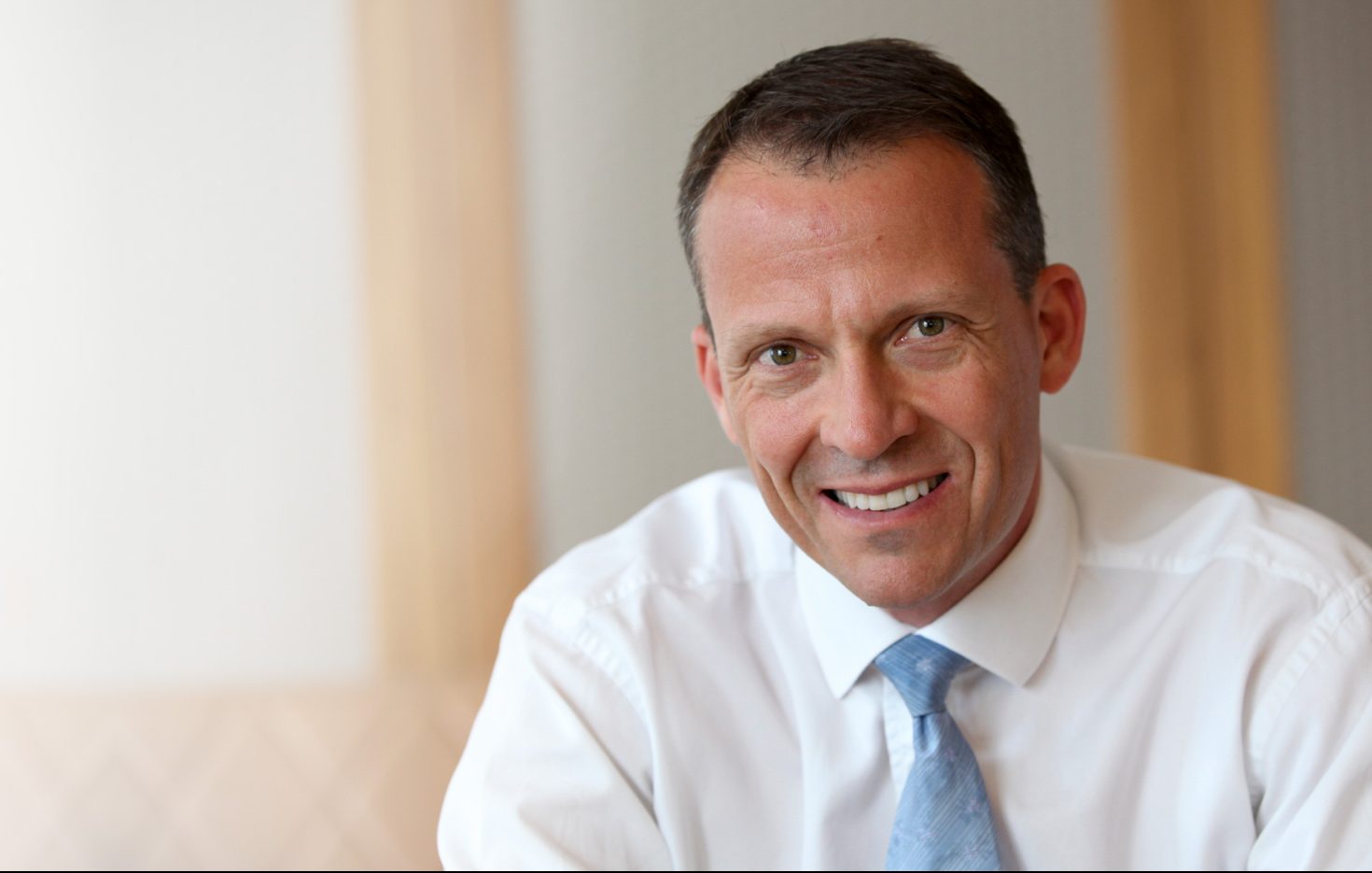
Find out about
Crispin Murray’s Pendal Focus Australian Share Fund
China
The first week of the National People’s Congress session did not yield much in the way of surprises.
The 2024 GDP growth target has been set at “around 5%”, which was largely as expected.
There has been rhetoric around AI, automation, technology, renewables, new energy vehicles (NEVs) and biotech as drivers of economic growth.
A special sovereign bond issuance plan, estimated to be around RMB 1 trillion for 2024, is designed to help mitigate the risk of local governments struggling to pay debt.
Markets
The small 0.23% fall in the S&P 500 meant that it only equalled its best run on record of rising in sixteen of the last eighteen weeks – last seen in 1971.
We note that on a historical basis, a strong start to the year typically has some persistence.
Going back to 1950, when the S&P 500 has risen in January and February, it has gone on to record gains over the remaining ten months of the year 92.9% of the time, with an average return of 8.1%.
That said, we also observe that this is starting to look like a relatively long run without a 2% retracement on a historical basis.
The put/call ratio is at the bottom end of its range, suggesting that sentiment remains very bullish.
In other news, as expected, OPEC+ agreed to extend the current curbs on oil supply through to June in order to support prices.
However, the gas price remains weak due to the combination of a mild European winter, high levels of gas in storage, and emerging concerns about increased supply from Qatar.
We also saw index changes on the ASX.
QBE Insurance (QBE) replaced Newmont (NEM) in the S&P/ASX 20, while Flight Centre (FLT) and Pro Medicus (PME) moved into the S&P/ASX 100, and Alumina (AWC) and Region Group (RGN) fell out.
About Crispin Murray and Pendal Focus Australian Share Fund
Crispin Murray is Pendal’s Head of Equities. He has more than 27 years of investment experience and leads one of the largest equities teams in Australia. Crispin’s Pendal Focus Australian Share Fund has beaten the benchmark in 12 years of its 16-year history (after fees), across a range of market conditions.
Pendal is an independent, global investment management business focused on delivering superior investment returns for our clients through active management.
Find out more about Pendal Focus Australian Share Fund here.
Contact a Pendal key account manager here.
Drawing on more than 25 years of experience investing in top-performing Australian companies and a background in accounting, Jim manages our Long/Short Fund and co-manages our Imputation Fund. He is a Chartered Accountant with membership of the Australian Institute of Chartered Accountants.
Pendal Focus Australian Share Fund is managed by Crispin Murray. The fund has beaten its benchmark in 14 years of its 18-year history (after fees), across a range of market conditions. Find out more about Pendal Focus Australian Share Fund here.
Pendal is an independent, global investment management business focused on delivering superior investment returns for our clients through active management.
Lessons from the latest GDP data | How to invest in troubled times | AI opportunities outside the Magnificent Seven
While the US-based ‘Magnificent Seven’ takes the spotlight, several ASX-listed companies are leveraging of AI technology, reports Pendal analyst ELISE McKAY
- Xero is close to testing an AI-based business companion
- NEXTDC is building local AI infrastructure
- Find out about Pendal Focus Australian Share fund
ON A TOUR of the US late last year, Pendal Aussie equities analyst Elise McKay met with dozens of companies – and found generative AI was a topic in almost every meeting.
“There’s strong evidence that over the longer term generative AI will have a big impact across the business landscape,” McKay said at the time.
Aussie equities investors should keep an eye on how companies are investing in AI, as well as which infrastructure suppliers are best placed to benefit in a fast-evolving market.
Below is an update from McKay, outlining how her expectations are playing out after the recent ASX results season.
Here she focuses on ASX-listed data centres player NEXTDC and software maker Xero – both held by Pendal.
XERO (ASX: XRO)
Generative AI – a machine-learning model that is trained to create new data, content and insights – is being embraced globally as corporates leverage “large language models” and infrastructure available off the shelf.
Xero – a cloud-based finance and accounting software maker – is a good example.
At its inaugural investor day, Xero announced a generative AI tool called JAX (short for Just Ask Xero).

The tool is designed to help customers with personalised insights and tasks such as raising and sending invoices to customers.
Xero plans to test the tool with customers later this year.
Xero first started working on its generative AI strategy about eight months ago and made a key hire in Eitan Sharon as its data and science lead in November.
Within months of Eitan joining, Xero had a functional tool in place, demonstrating the speed with which these products can be built and deployed.
NEXTDC (ASX: NXT)
With rapid growth in demand for generative AI tools comes demand for infrastructure to run and support training and inference models.
Training refers to the process of building AI models, while inference refers to how those models are deployed in an application or business setting.
Focus is expected to shift from AI training to inference over time – which may advantage some players and disadvantage others.

Australian data centre operator NEXTDC (ASX: NXT) hopes to play a significant role in both markets.
NXT is expected to launch its first Nvidia-based “AI factory” in coming months.
It’s our expecation the AI factory will use graphics processing units made by Nvidia – the $US 2 trillion-dollar NASDAQ-listed chipmaker that has become the face of the artificial intelligence hardware manufacturing race.
This would be complementary to existing NXT data centre infrastructure which is ideally positioned to hosts inference model technology – which requires proximity to clients to limit latency.
NXT has recently signed contracts with hyper-scale players in Sydney and Melbourne to support their cloud deployments.
AI deployments would be over and above these contracts, and — if following the US trend — at a size significantly larger than what has recently been signed.
There are now also contracts being tendered in market for sizeable AI deployments for both training and inference needs. These are reportedly significantly larger in size again than recent contracts.
Demand for onshore AI infrastructure
NXT’s customers are expected to differentiate their needs depending on whether they are contracting for training or inference work.
But in both cases, Australian clients prefer onshore AI infrastructure technology due to data sovereignty issues and the need for low latency.
Training models can be located close to wherever access to power is available and priced cheaply, while inference models need to be in metro locations.

Find out about
Pendal Horizon Sustainable Australian Share Fund
This is well-suited to NXT’s footprint which is spread geographically across six states and territories of Australia and closely located to CBDs.
NXT is well positioned to win its fair share with available inventory in all markets and great relationships across the customer base.
Access to power
Access to power is one of the big issues that continues to face the AI industry
Data centres, crypto currencies and AI consumed 2% of global energy demand in 2022, the International Energy Agency estimates.
The IEA forecasts global demand for energy from these sources to grow at 8% to 23% from 2022 to 2026.
In the US, data centres accounted for about 4% of energy demand in 2022. They are expected to account for half of US electricity demand growth over the next three years.
Clearly the AI industry needs resolve this issue to meet demand.
The issue will be attacked from multiple angles including increased compute efficiency (eg Huang’s law), new cooling technologies (eg direct-to-chip cooling, liquid immersion) and innovative power solutions (eg small modular reactors).
About Elise McKay and Pendal Australian share funds
Elise is an investment analyst and portfolio manager with Pendal’s Australian equities team. Elise previously worked as an investment analyst for US fund manager Cartica where she covered a variety of emerging market companies.
She has also worked in investment banking and corporate finance at JP Morgan and Ernst & Young.
Pendal Horizon Sustainable Australian Share Fund is a concentrated portfolio aligned with the transition to a more sustainable, future economy.
Pendal Focus Australian Share Fund is a high-conviction equity fund with a 16-year track record of strong performance in a range of market conditions. The Fund is rated at the highest level by Lonsec, Morningstar and Zenith.
Pendal is an independent, global investment management business focused on delivering superior investment returns for our clients through active management.
The December-quarter GDP numbers just stopped short of the “no-growth” scenario we were slowly sliding towards last year. Pendal’s head of government bond strategies TIM HEXT explains what it means for markets
- Weakness largely derived from consumer spending
- On a nominal basis, the picture looks better
- Why bonds, why now? Pendal’s income and fixed interest experts explain
- Browse Pendal’s fixed interest funds
THE December-quarter GDP numbers just stopped short of the “no-growth” scenario we were slowly sliding towards last year.
Q4 GDP came in on forecast at just 0.2%, as you can see in the ABS graph below.
After 2.3% growth in 2022, 2023 finishes with GDP at 1.6%.
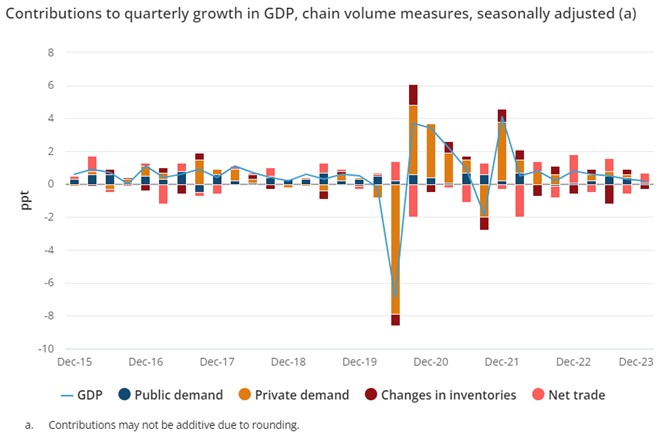
Source: ABS, 2024
In per capita terms, we went backwards for the third quarter in a row (-0.3% for the quarter) and are down 2.4% over 2023.
The weakness is largely from consumer spending, which is going almost nowhere – this was up 0.1% for the quarter and 0.1% for the year.
Remember, this was a year where almost 600,000 people entered the country so, on average, we are all spending less than in 2022.
Interestingly, we are earning more, but it is all being swallowed up by inflation, interest rates and tax creep.
In fact, compensation of employees was up 8.1% in 2023, but taxes paid 11.5%. The Stage 3 tax cuts (beginning July) will only partly remedy this.
READ NEXT: What are the main factors impacting income strategies right now? In a new article, Pendal’s head of income strategies AMY XIE PATRICK explains how her view has evolved in recent months. Read the article here
If you feel like money is going out just as fast as it comes in, you have good reason.
The GDP you hear reported is a volume measure (called chain volume) of output for the economy.
Most of us think in nominal terms.
On a nominal basis things look better – with GDP at 1.4% for Q4 and 4.4% for 2023.
Higher prices and improving terms of trade has helped cushion the blow in the real economy.
Government and business investment propping up the economy
So, if consumer spending – which makes up 50% of the economy – is flatlining, then where is the modest growth coming from?
Government spending and investment continues to be strong.
Government spending was up 0.6% for the quarter and 2.7% for the year, while government investment was slightly down for the quarter but up a massive 13.6% in 2023.
Private investment was up as well, but modest overall.
Data centres and warehouses are driving solid growth.
Concerningly though, dwelling investment was down 3.8% for the quarter and down 3.1% on the year.
Hopes of a building boom to help the housing shortage fly in the face of higher interest rates.
Rents go up, so inflation goes up, so interest rates go up, so housing investment falls – if you follow the logic of rate hikes to tackle rental inflation, you are smarter than me.
Hours worked still falling
The GDP numbers also include data on hours worked.

Find out about
Pendal’s Income and Fixed Interest funds
This fell for the second quarter in a row and is now down 1% from mid-year.
The RBA will take some comfort that firms are responding to slower conditions by reducing hours of existing employees and not hiring new ones, rather through layoffs – at least for now.
So, what does this mean for markets?
First of all, the rate hikes have worked.
While the fixed rate cliff has been more of a speed bump, the RBA will be pleased that higher rates are reducing demand in the economy.
Lower immigration in the year ahead will also help.
At the same time, the supply side of the economy is another year away from the pandemic and has now largely normalised.
This will give the RBA further comfort that its path back to inflation below 3% is realistic and achievable.
This, in turn, opens the door to rate cuts later in the year.
We still think three cuts – in September, November and December – are realistic.
By then, the US Federal Reserve should be well into rate cuts, and inflation – while sticky around 3% – would be considered under control.
In turn, GDP would be allowed to push back up towards 2% or above without threatening the inflation outlook – and this would be a good outcome for all and meet the objectives of the RBA.
About Tim Hext and Pendal’s Income & Fixed Interest boutique
Tim Hext is a Pendal portfolio manager and head of government bond strategies in our Income and Fixed Interest team.
Tim has extensive experience in banking, financial markets and funding including senior positions with NSW Treasury Corporation (TCorp), Westpac Treasury, Commonwealth Bank of Australia, Deutsche Bank, Bain & Co and Swiss Bank Corporation.
Pendal’s Income and Fixed Interest boutique is one of the most experienced and well-regarded fixed income teams in Australia.
Find out more about Pendal’s fixed interest strategies here
About Pendal
Pendal is a global investment management business focused on delivering superior investment returns for our clients through active management.
In 2023, Pendal became part of Perpetual Limited (ASX:PPT), bringing together two of Australia’s most respected active asset management brands to create a global leader in multi-boutique asset management with autonomous, world-class investment capabilities and a growing leadership position in ESG.
What are the main factors now affecting fixed income investors? Pendal’s head of income strategies AMY XIE PATRICK explains how her view has evolved in recent months
- There could be heightened volatility and bouts of “everything sell-offs”
- A hard landing isn’t off the table, but it’s too soon to position for it yet
- Why bonds, why now? Pendal’s income and fixed interest experts explain
- Browse Pendal’s fixed interest funds
Will US 10-year yields end the year closer to 3% or 5%?
Three months ago, I would have put a 70% probability on 3%.
Today, I’m a fence-sitter – though there are arguments for both sides of the fence.
The main thing that’s changed is…well…nothing. The consumer is still incredibly resilient. It’s not clear where that resilience is coming from, but here’s a theory.
Excess savings buffers have been wearing down since the pandemic, but one thing after another has offset the economic effect.
In 2023, an increasing budget deficit found its way into the pockets of US consumers. In Australia, an influx of immigration kept aggregate consumption at a healthy level, even if individually we were feeling more mixed.
The latest saving grace has been disinflation.
Prices move faster than wages on the way up and on the way down. Put another way, real incomes are eroded in periods of high inflation, and boosted when inflation falls.
This has a direct impact on consumer sentiment, which feeds into consumption.
In Australia there is a strong relationship between real incomes and sentiment. Real wages seem to lead sentiment by about three months.
Even as savings buffers wane, a fall in inflation has boosted real consumer spending power.
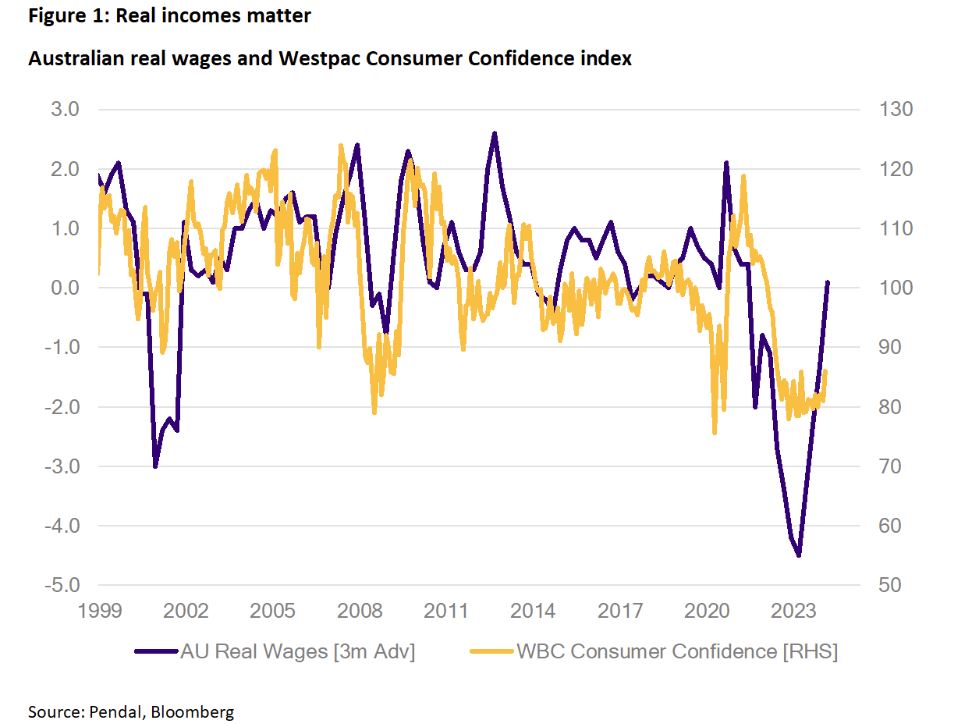
Disinflation is no longer enough
Ironically, falling inflation has been my main reason for liking bonds over the past six months.
Big moves lower in bond yields in the fourth quarter of 2023 seemed like vindication for those views.
But as Pendal’s income and fixed interest team watched the data roll in over December and January, we realised disinflation alone would not be enough to justify a large gap between the market’s pricing and the Fed’s dots.
By the end of 2023, interest rate markets had priced in more than seven rate cuts from the Fed in 2024. Though the median of the Fed’s projections saw only three cuts.
Implicit in my previous view was an assumption that falling inflation would be accompanied by a slowing economy.
As labour markets loosened, consumption would also slow to reflect greater uncertainty on jobs.
If such a macro picture was to play out in the data (and it still might), the Fed and other central banks would be able to lower rates more concertedly.
They wouldn’t need to worry about a rebound in inflation because the gravitational forces of slowing demand would be there to help.
As Figure 2 shows, the disinflation thesis is still intact.
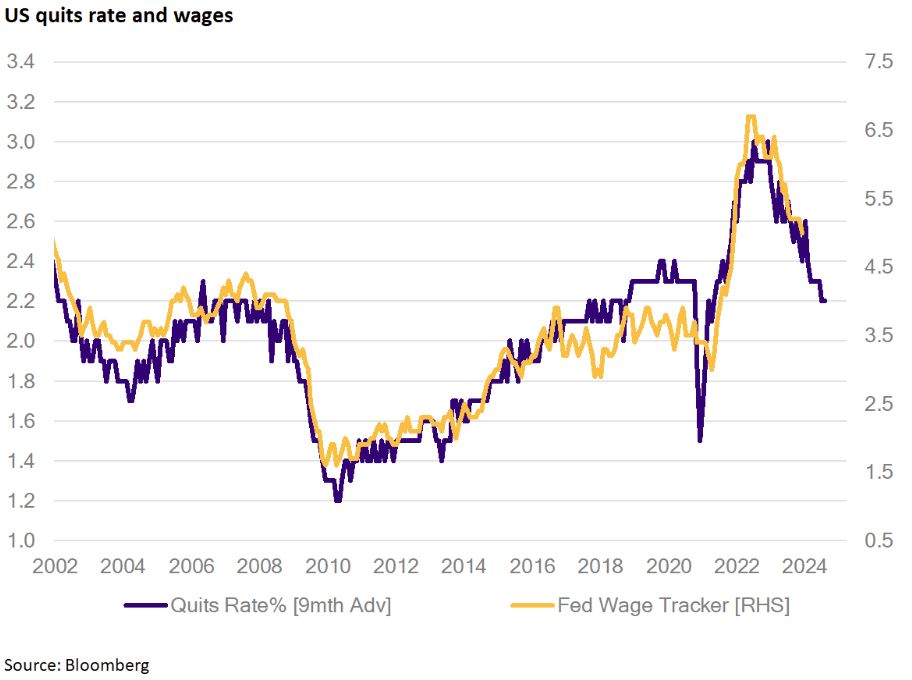
There has been a long-held relationship between the quits rate and wages.
The reasoning is fairly intuitive: we feel less bold about quitting when the prospects of other jobs decline. Empirically, the quits rate seems to lead wage growth by around three quarters.
The data for US consumption tells a different story, which throws a spanner in the works for bond enthusiasts.
Personal consumption expenditure (or PCE) turned a corner in 2023 and remains robust.
Consumer sentiment is rebounding more sharply because real incomes are rising.
Since consumption counts for about 70% of US GDP, it’s hard to build a case that the economy is faltering just yet.
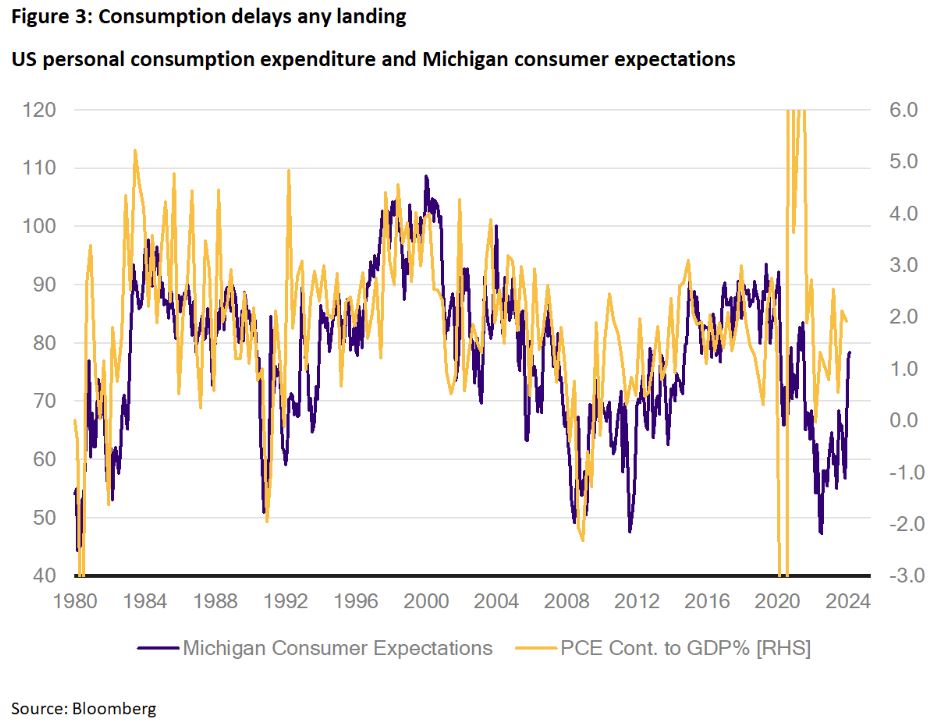
What if there is no landing?
Consumption is now so resilient it’s got the market questioning whether there will be any landing, let alone a hard landing.
In the US, it’s not just consumption.
Manufacturing seems to be stabilising, housing has turned a corner, and the fiscal drag is barely noticeable. Could the next move from the Fed be a hike?
I’m not yet ready to get quite so carried away, but I concede that it’s simply too early to start positioning uber-defensively in portfolios.
Regardless of whether I agree with the no-landing narrative, good portfolio management requires me to entertain that scenario and consider the ramifications for investment decisions.
A no-landing scenario would imply we’ve already moved past any mid-cycle slowdown.
It would support equity analyst earnings growth estimates of around 7.5% this year for the S&P 500 index.
It would give comfort to the idea that high-yield credit spreads can stay lower than what should be implied by recent rising default rates because the worst is already over.
It would also challenge the market and the Fed’s current thinking on rate cuts for this year.
In fact, some argue that if the US economy is still managing to grow above trend with a 5.5% Fed Funds rate, then monetary policy isn’t all that restrictive.
Taken to its conclusion, this train of thought poses risks to bonds.
Since bond and equity returns have been positively correlated since late-2022 – excluding the Silicon Valley Bank blip last year – the idea of no-landing also poses a threat to risky assets.
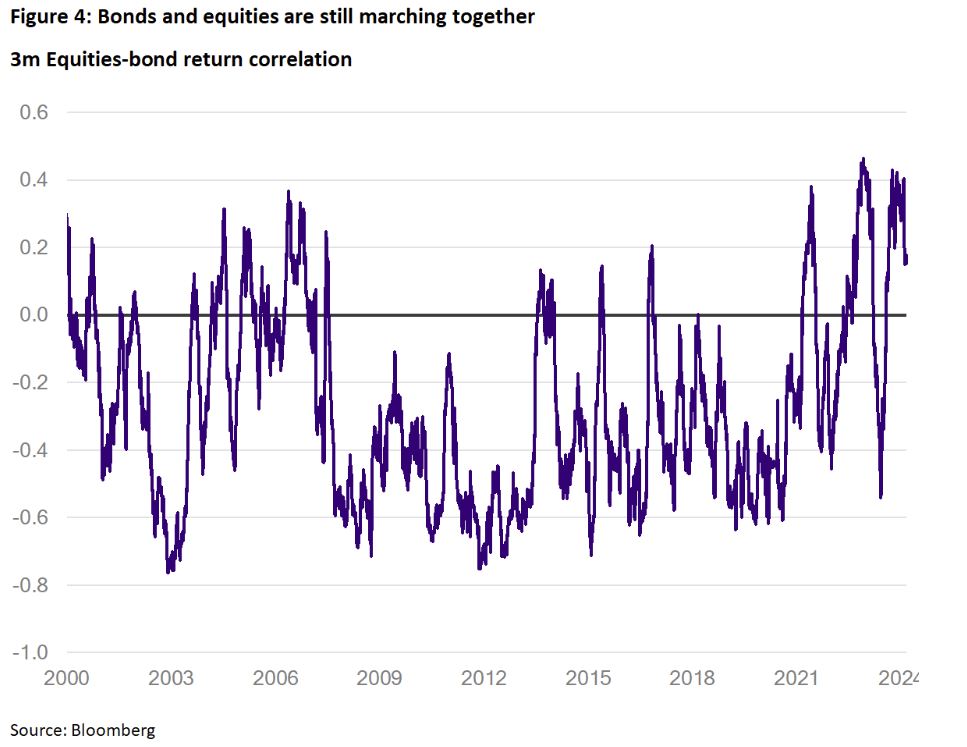
Volatility is an opportunity
As I entertain the possibility of a no-landing scenario, at least for 2024, I am drawn to a few investment implications.
The first is that I need to be truly active on duration this year.
Set-and-forget on bonds won’t work. Our income strategies carried over five years of duration at the end of 2023, which is more than the AusBond Composite Index (Australia’s most popular fixed income benchmark).
Roughly speaking, that translates to a 5% performance move for the portfolio for every 1% move in yields.
Today, these portfolios carry less than one-tenth of that exposure (so nearly no duration at all).
Not only did this help our funds benefit from the strong moves lower in global bond yields at the end of 2023, but also helped us to avoid the decent back-up in yields since the start of 2024.
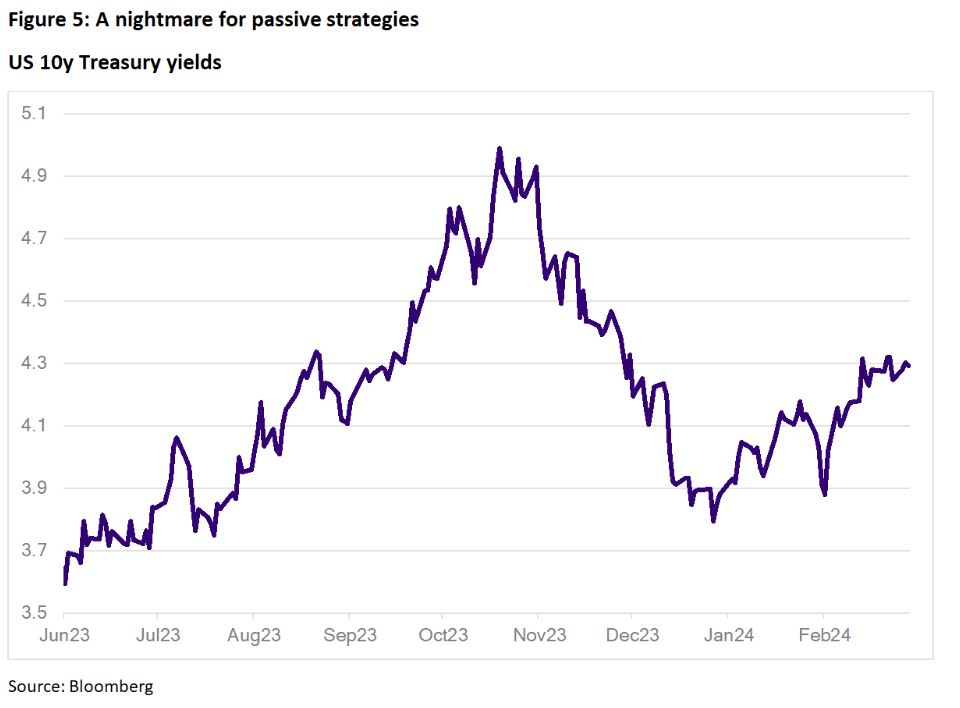
The second is that I should expect flashbacks to 2022, where almost everything sold off together.
The main driver will come from bonds and knock-on to other asset classes.
Since our income funds can only be long or square in risky assets, maintaining a liquid portfolio so that we can de-risk out of the riskiest pieces quickly will count for a lot in that environment.
The third is that it’s too soon to get uber-defensive.
Investment grade credit is still a good place to stay in risk while avoiding over-extension.
Bringing this allocation down too much and too soon may mean leaving good quality returns on the table.
On top of that, I need to remain open to buying opportunities in riskier assets such as equities.
After all, the ASX 200 was largely directionless and volatile until the back end of 2023, yet our Monthly Income Plus portfolio was able to seize on the opportunities afforded by the volatility.
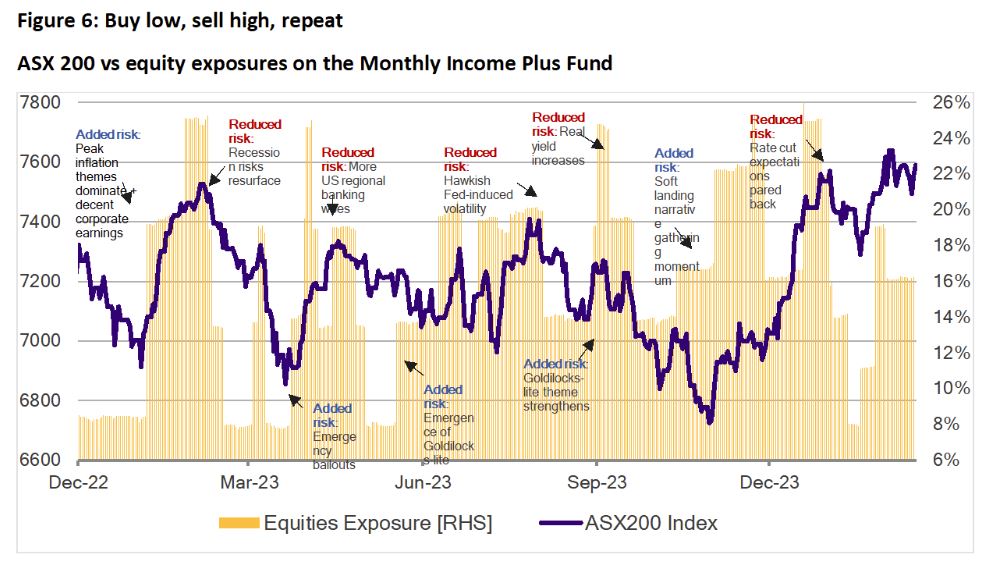
Hard landing is not off the table
While I am not ready to buy-in to the no-landing camp, I acknowledge data now supports that narrative.
Having a plan for how to navigate a no-landing market environment is key. Having the flexibility to enact that plan is vital. Portfolio liquidity will be very important this year.
It is worth stressing that a hard landing isn’t off the table.
Just as my subjective odds for a no-landing scenario in 2024 has increased, the odds I assign to a hard landing has diminished.
It is probably just as likely to happen in the first half of 2025 as in the second half of 2024.
How we get there will be one of two ways.
The first would be something that looks like a soft landing, but carries on softening.
Historical experiences of recessions tells us that it happens gradually, then suddenly (to paraphrase Hemingway).
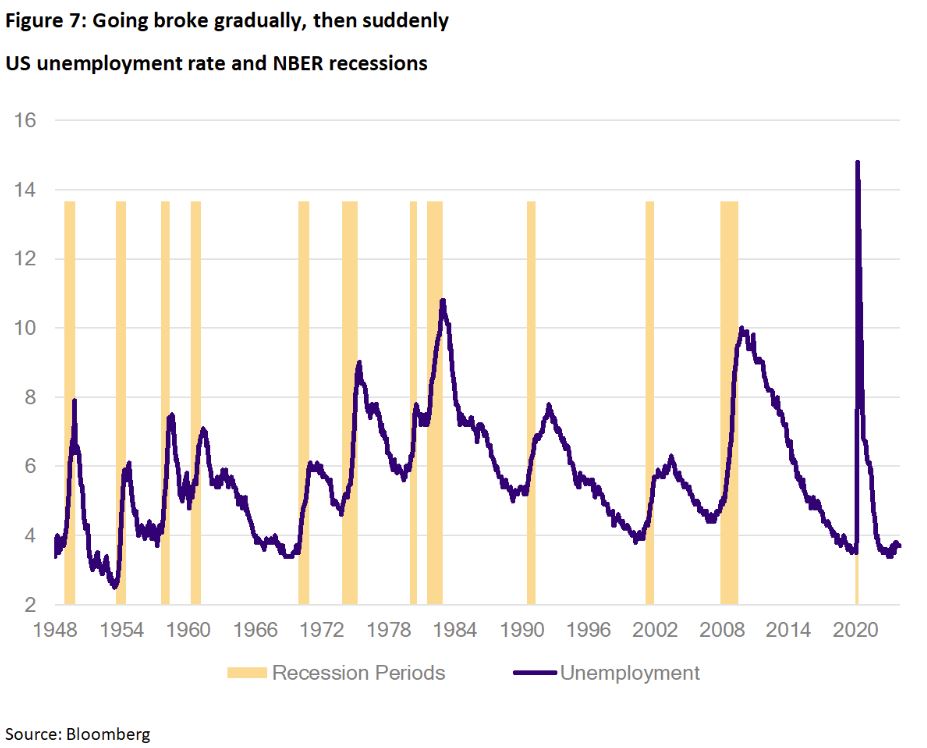
The explanation for this is not unanimously agreed upon, but it probably has something to do with how hard it is to find a neutral policy point when the economy is at full capacity or full employment.
When the economy is at full employment every extra bit of demand pushes prices higher, causing inflation to soar. Any weakening in demand creates extra capacity and the potential for layoffs as companies cut costs.
The trickiest bit to all of this is knowing that monetary policy hits the economy with a lag, but not knowing how long that lag really is.
The safest bet for central bankers with price stability in their mandates is to err on the side of caution, over-tighten to get inflation under control, and hope they can ease policy in time to avoid a really hard landing.
The track record on that last bit hasn’t been great, though.
This cycle poses extra challenges in figuring out the lags.
Did the post-pandemic fiscal stimulus lengthen the lags? Has a largely fixed-rate US mortgage market dampened the pass-through effect of higher interest rates?
Has immigration weakened the link between interest rates and our housing market?
I wish I had all the answers, but I do know this: not all households and corporates managed to fix the rate on their debt at super-low rates.
Corporate defaults have been rising in spite of strong economic growth which means there is buckling at the edges.
Rising delinquencies on consumer loans and credit cards are signs that policy has become restrictive.
At some point, the edges creep into the middle. The lagged effects finally show up, tail risks become the central risk, and the gradual recession becomes a sudden one.
The second way to a hard landing is via no landing. This would push the timing more towards next year.
A no-landing scenario raises the chances that inflation will resurge.
I’m not a massive subscriber to this view as I think there is enough in the inflation and wage data to support a continued disinflation trend.
But I acknowledge that markets will not take kindly to any disappointment on inflation.
A more likely version of this path to hard landing is that during a no-landing phase, central banks feel reluctant to cut rates.
As the lagged effects of restrictive policy catch up with the real economy, the economy eventually falls into a hard landing.
This may also be why the US yield curve has stayed inverted.
Active decisions in times of uncertainty
Let’s bring this back to positioning implications.
The summary of my view change from a few months ago is that I am still not seeing a step down in consumer appetite.
That means disinflation alone is insufficient for driving a strong rally in bonds.
In addition, near-term risks may be skewed to further bond volatility as the market tries on the no-landing narrative.
For our income portfolios, our long bias on duration has eased, and I’m happy to tactically take duration exposures all the way down to minimal levels.
I still like bonds and higher yields offer great asymmetry.
But I really like bonds because I think the hiking cycle (at least in the US) is over.
In an active portfolio, the way to express this is to buy-on-dips and be prepared to take the gains when you have them.
At least for the next couple of months.
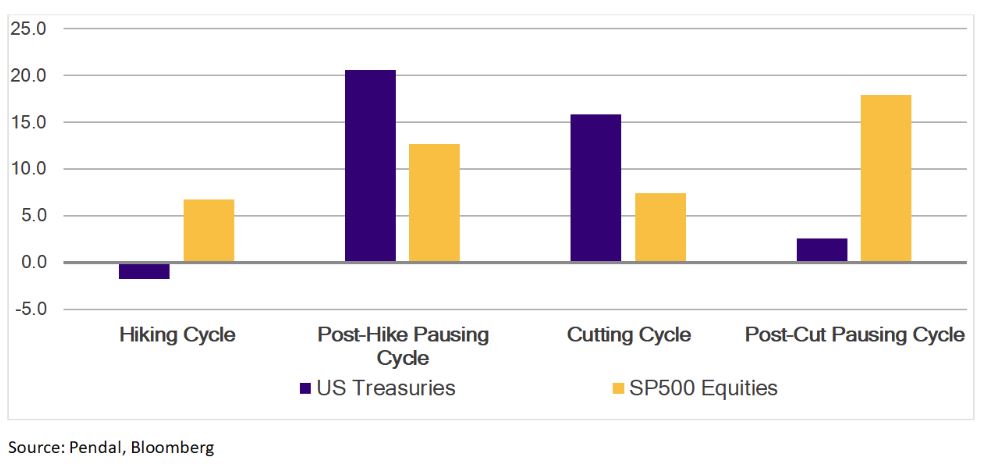
I also won’t say no to buying dips in risky assets along the way.
Equities (and credit) do well as long as growth holds up. The prolonged “everything sell-off” in 2022 had as much to do with a deteriorating growth outlook as it did soaring inflation.
It’s hard for anything to do well in the face of stagflation.
In 2024, as long as the growth backdrop remains healthy, everything sell-offs are likely to be good buy-the-dip opportunities.
The core returns driver in our income strategies continues to be high-quality, investment-grade credit.
The pace of corporate bond issuance in Australia has started this year with a bang, all met with very strong demand.
While selective, our portfolios have not shied away from participating in those opportunities.
But I’m keeping an eye on default rates.
As Figure 9 shows, tightening credit conditions tend to lead to higher default rates with a decent lag.
Even though lending standards have begun to loosen, default rates are still rising.
So far, global credit spreads have shrugged off higher default rates, which would be correct if the soft landing has already happened.
However, if this old relationship holds, having a higher quality and liquidity bias in our credit portfolios will give us the resilience and flexibility to navigate an uglier market environment.
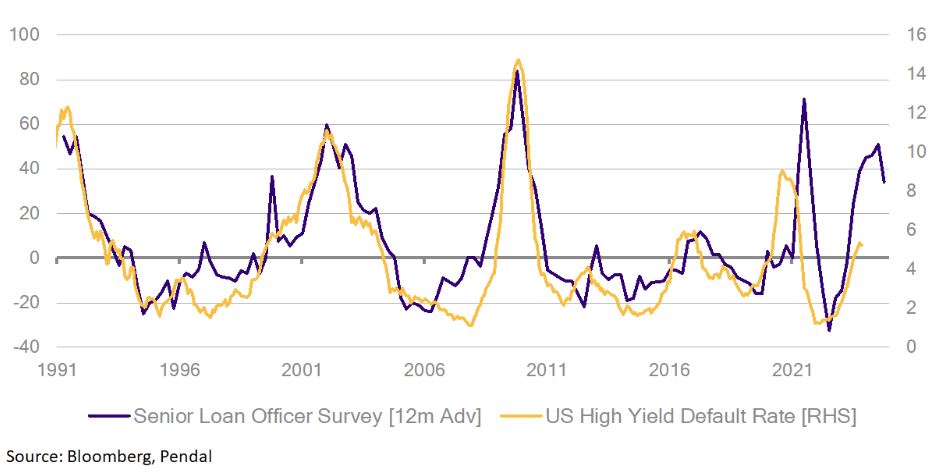
About Amy Xie Patrick and Pendal’s Income and Fixed Interest team
Amy is Pendal’s Head of Income Strategies. She has extensive expertise and experience in emerging markets, global high yield and investment grade credit and holds an honours degree in economics from Cambridge University.
Pendal’s Income and Fixed Interest boutique is one of the most experienced and well-regarded fixed income teams in Australia. The team oversees some $20 billion invested across income, composite, pure alpha, global and Australian government strategies.
Find out more about Pendal’s fixed interest strategies here
About Pendal Group
Pendal is a global investment management business focused on delivering superior investment returns for our clients through active management.


